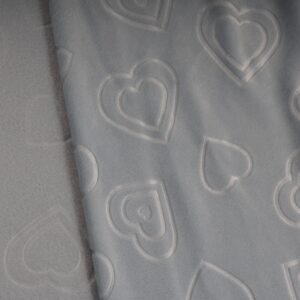The most prevalent debate that runs through consumers and manufacturers when choosing fabrics for baby blankets, loungewear, throws, and plush toys is: Between minky fleece fabric and cotton, which is softer? These two fabrics are among the most popularly used fabrics yet they have significant disparities in fiber content, tactile qualities, durability, and end uses.
This article shares a detailed comparison between minky fleece and cotton on softness, construction, application differences, care requirements as well as environmental considerations for buyers, textile brands, and consumers to make better decisions.
What is Minky Fleece Fabric?
Minky fleece fabric, in some cases known as rich fleece or minky extravagant, is a manufactured texture regularly produced using 100 percent polyester strands. It is described by outstandingly delicate surfaces: Its brushed heap surface gives it a smooth hand feel. The texture is firmly weave, and that implies there are no holes and gives warmth. Minky comes in smooth, spotted (raised spot surfaces), embellished, or designed variants.
Common applications are baby blankets, stuffed animals, bathrobes, throws, accent pillows, and anything else that goes for comfort. Minky fleece is a synthetic fiber; therefore, it does not take on any of the inconsistency that most natural fibers develop in their feel after washing or as they age. For this reason- its texture has kept it very common within markets for products relating to kids and babies.
Is Minky Fleece Fabric Softer Than Cotton?
In general, minky fleece fabric is softer as compared to cotton, particularly standard woven cotton. The structure of the fiber and finishing is the difference:
The softness of cotton depends on its thread count, finishing treatments, and the length of the fiber. That being said, premium Egyptian or Pima cotton can end up being very soft while standard varieties usually feel crisp and harsh to the touch before several washings.
Minky softness is not a natural phenomenon but man-made; its extruded polyester fibers simulate the smoothness of silk, and the brushed pile surface improves on velvet softness that never wears off.
Parents prefer minky over cotton for blankets for their baby because the baby reacts positively to the silky touch. However, it still has the upper hand in terms of breathability and absorbing natural moisture content, which makes it ideal to be worn during summers.
Main Raw Materials of Minky Fleece
- Polyester microfibers- these are ultra-fine fibers that actually make the fabric get a silky, plush touch.
- Polyester filament yarns- they give structure to the fabric as well as strength and stretch resistance.
- Occasionally blended fibers- seldom but some manufacturers experiment with spandex or recycled PET blends to improvise more stretch or sustainability.
Since synthetic fibers are used, the minky fleece is durable, colorfast, and fade-resistant.
Common Production Processes of Minky Fabric
The softness and density of minky fleece result from specialized production techniques:
- Knitting – Minky is knit rather than woven, creating flexibility and stretch.
- Brushing – Fabric is brushed on the surface to raise the pile and achieve velvet-like softness.
- Heat setting – Stabilizes the fibers to resist shrinking and distortion.
- Embossing – Some varieties feature embossed or dotted textures created through heat pressure.
- Dyeing/Printing – Polyester dyes produce vivid, long-lasting colors and patterns.
These processes ensure the final product remains plush and retains softness even after repeated use.
Types of Minky Fleece Fabric
Minky fleece is available in multiple variations:
- Smooth Minky – a classic velvety surface with no raised textures.
- Minky Dot – features raised dots that add sensory appeal, especially for baby products.
- Minky Sherpa – designed to mimic wool or sheepskin, providing a fluffy, textured feel.
- Minky Embossed – includes patterns like hearts, stars, or animal prints embossed into the fabric.
- Minky Stretch – enhanced with elasticity for clothing or fitted covers.
Each type is chosen based on the final product requirements, whether for warmth, decoration, or tactile stimulation.
Does Minky Fleece Shed Fibers?
Shedding is a concern for any plush fabric. With high-quality minky fleece, shedding is minimal because:
- Fibers are tightly knit into the base structure.
- The pile is heat-set to reduce loose fibers.
- Lower-quality versions may shed initially. To prevent this:
- Wash before first use.
- Avoid high-heat drying.
- Choose reputable manufacturers who guarantee anti-shedding finishes.
Is Minky Fleece Safe and Suitable for Sensitive Skin?
Yes, Minky fleece is indeed soft and gentle enough for sensitive skin, even that of babies.
Its hypoallergenic polyester fibers, the smooth pile that hardly creates friction, and also versions available in OEKO-TEX Standard 100 certification for safety assurance make it possible.
Wool can be itchy; certain cotton fabrics are not coarse; minky fleece always provides a consistent sensation of silkiness.
Applications of Minky Fleece Fabric
Because of its softness and durability, minky fleece is widely used in:
- Baby products: blankets, swaddles, plush toys.
- Home textiles: throws, cushion covers, bedding.
- Apparel: robes, jackets, loungewear.
- Pet accessories: beds, blankets, toys.
Its warmth and softness make it particularly suitable for cold-weather products.
Ease of Cleaning and Maintenance
Minky fleece is relatively easy to maintain:
- Machine washable on gentle cycles.
- Air dry or low heat tumble to preserve pile texture.
- Avoid fabric softeners and bleach, as they can damage fibers.
Cotton may shrink and wrinkle with washing, while minky maintains its original form and softness.
Environmental Aspects of Minky Fleece
As a synthetic fabric, minky fleece raises sustainability concerns:
- Not biodegradable – polyester fibers persist in the environment.
- Microfiber shedding – may contribute to microplastic pollution.
- Recycled options available – some manufacturers now offer minky fleece made from recycled PET bottles.
Cotton, on the other hand, is biodegradable but requires large amounts of water and pesticides in conventional farming. Both materials have sustainability trade-offs.
Functional Treatments for Minky Fleece
Minky fabrics can be engineered with additional properties:
- Flame retardant finishes for safety.
- Anti-static treatments to reduce static build-up.
- Anti-pill finishes to prevent fuzzing.
- Moisture-wicking variants for added comfort.
These treatments expand the application range of minky fleece in specialized industries.
Breathability and Seasonal Suitability
Minky fleece is warm but less breathable compared to cotton. This makes it more suitable for:
- Cold seasons – blankets, throws, jackets.
- Indoor cozy wear – robes, loungewear.
Cotton remains superior for hot climates or breathable summer apparel. Many consumers choose cotton for sheets and summer garments, reserving minky fleece for cold-weather comfort.
Customization Options
Textile buyers and brands often require customization. Minky fleece supports:
- Custom colors and prints via digital printing and dye sublimation.
- Embossed textures with logos or patterns.
- Custom thickness and pile length for varied applications.
This makes it a favorite in both the toy industry and premium home décor market.
Quality Control Issues: Pilling, Shedding, and Durability
To maintain premium quality:
- Select high-density minky (measured in GSM).
- Ensure anti-pill finishing treatments are applied.
- Test products for colorfastness and wash durability.
Inferior quality minky may pill or flatten after several washes, but high-quality versions can remain plush for years.
Comparing Minky Fleece with Sherpa and Cotton
Many buyers compare minky fleece with sherpa fleece and cotton fabrics. Below is a comparison table:
| Feature | Minky Fleece | Cotton Fabric |
| Softness | Ultra-soft, silky pile | Varies (can be crisp or soft) |
| Breathability | Low | High |
| Warmth | High | Medium |
| Durability | Very durable, resists fading | Durable but may shrink/wrinkle |
| Care | Easy, machine washable | Easy, but prone to shrinkage |
| Environmental Impact | Synthetic, non-biodegradable | Natural, biodegradable (but water-intensive) |
| Customization | Embossed, printed, dyed | Dyed, woven, printed |
This comparison shows why consumers often use both fabrics strategically rather than exclusively.
Which is Better: Minky or Sherpa?
Sherpa fleece fabric is another fleece-like fabric designed to mimic wool. Compared to minky:
Sherpa is fluffier and warmer.
However, Minky fleece fabric is smoother and retains a velvet-like touch.
The choice depends on whether warmth or smoothness is the priority.
Conclusion
So is minky fleece softer than cotton? Yes, generally, minky fleece feels much softer because of its engineered polyester microfibers and plush finishing as most other fabrics without practical applications are finished and microfiber fleece fabrics for all-over prints on the face and solid coloring on the back.
But softness is not the only factor to base your fabric decision on. Cotton material is way more breathable and eco-friendly; therefore, minky fleece fabric would be the perfect choice to use in applications where the material would feel plush and cozy only.
Three years later, and the choice in most instances for brands and buyers in 2025 mainly comes down to product type: breathable summer apparel and bed linens are still cotton, baby blankets, plush toys, winterwear, and comfort accessories are still minky fleece. Innovations in recycled polyester and eco-finishes make minky fleece sure to stay a front running fabric in home textiles and children’s products.





